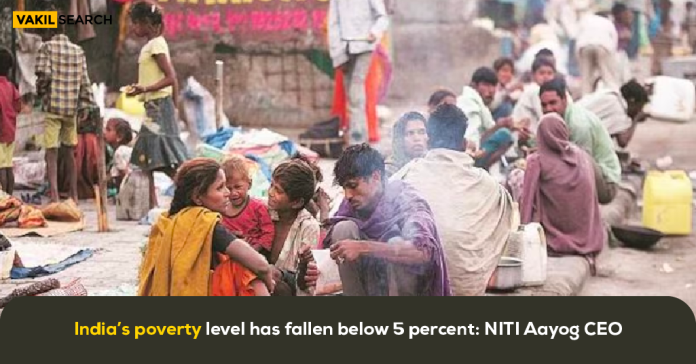The latest household consumer expenditure survey indicates a significant milestone in India’s fight against poverty. NITI Aayog CEO, B.V.R. Subrahmanyam, announced that the poverty level has plummeted below 5%, showcasing a remarkable improvement in the nation’s economic landscape. This positive trend is evident in both rural and urban areas, with the average per capita monthly expenditure witnessing a substantial increase compared to previous years.
According to data released by the National Sample Survey Office (NSSO), the average per capita monthly household expenditure more than doubled in 2022-23 compared to 2011-12. This surge reflects a rising level of prosperity across the country. Subrahmanyam highlighted that the success of poverty alleviation measures implemented by the government is reflected in the survey findings.
The survey categorises the population into 20 different groups, revealing that the average per capita monthly expenditure for all categories stands at ₹ 3,773 in rural areas and ₹6,459 in urban areas. Particularly noteworthy is the revelation that the average per capita monthly expenditure of the bottom 0-5% class is pegged at Rs 1,373 in rural areas and ₹ 2,001 in urban areas.
Subrahmanyam emphasised that when comparing these figures with the poverty line adjusted to today’s rates, it becomes apparent that poverty is primarily concentrated in the 0-5% group. However, he acknowledged the need for economists to conduct a thorough analysis to validate these assessments.
The NSSO survey, based on data collected from a vast number of households, indicates a significant increase in consumption levels in both rural and urban areas. This underscores the progress occurring nationwide, bridging the gap between urban and rural segments. Additionally, the survey factors in the positive impact of government welfare schemes, which have bolstered the consumption of poor households through provisions such as free foodgrains and essential goods.
A notable trend highlighted in the survey is the decline in the share of consumption of cereals and food in total household expenditure. This shift indicates a rise in prosperity, enabling households to allocate more resources to non-food items such as education, healthcare, and recreational activities. Subrahmanyam noted that this increased prosperity also leads to a diversification in dietary patterns, with individuals consuming more milk, fruits, and vegetables.
Moreover, Subrahmanyam pointed out that the reduced contribution of food to CPI inflation suggests a lower inflation rate overall, as food prices have been a significant driver of inflation in the past. This implies a more accurate reflection of inflation levels, aligning with the evolving consumption patterns observed in the country.
In summary, the latest survey findings depict a promising trajectory for India’s economic landscape, marked by a significant reduction in poverty levels and a notable surge in household prosperity, both in rural and urban areas.



